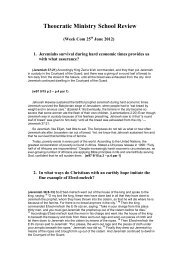1964 Awake! - Theocratic Collector.com
1964 Awake! - Theocratic Collector.com
1964 Awake! - Theocratic Collector.com
Create successful ePaper yourself
Turn your PDF publications into a flip-book with our unique Google optimized e-Paper software.
on pure cyanide, and they quickly solved<br />
the pollution problem.<br />
Many <strong>com</strong>munities that have found that<br />
their increasing volume of sewage is pol.<br />
luting streams and rivers are establishing<br />
sewage treatment plants. Here, with the<br />
aid of bacteria, the sewage is treated and<br />
the liquid that is finally dumped into a<br />
river or stream is free of contamination.<br />
In the treatment process air is applied to<br />
settled sewage for several hours, during<br />
which time bacteria act as oxidizing<br />
agent'>, changing the suspended matter in·<br />
to a granular brown mass that settles to<br />
the bottom of the treatment tank. The<br />
sediment is activated sludge that consists<br />
largely of microorganisms. They make it<br />
possible to convert sewage into uncon·<br />
taminated water.<br />
Source of Power<br />
Of all the useful services bacteria are<br />
capable of rendering to man, the most sur·<br />
prising is just now being discovered. It is<br />
electrical power. Automobiles, ships and<br />
even entire cities could be supplied with<br />
ample electrical power by bacteria. That<br />
this is feasible has been proved by what is<br />
called the biochemical fuel cell.<br />
One of the pioneer developers of the bio·<br />
chemical fuel cell is Dr. Frederick D. Sis·<br />
leI' of the U.S. Geological Survey. In 1961<br />
he succeeded in getting some electricity<br />
from two test tubes containing bacteria,<br />
organic matter and seawater. In one of<br />
his experiments, he obtained sufficient elec·<br />
tricity to operate a small radio transmitter.<br />
The biochemical fuel cell differs from<br />
the chemical fuel cell in that it uses bac·<br />
teria and organic matter to get electricity.<br />
The chemical fuel cell generates electricity<br />
directly from chemicals and chemical re·<br />
action. In the process hydrogen and oxygen<br />
are <strong>com</strong>bined to form water. These<br />
same gases are involved in the biochemical<br />
APRIL 8, 196ft<br />
fuel cell, but they are <strong>com</strong>bined by bacte·<br />
rial action.<br />
All organic material contains hydrogen,<br />
and when bacteria feed upon such mate·<br />
rial, hydrogen is forced to <strong>com</strong>bine with<br />
oxygen. Bacterial enzymes appear to pull<br />
electrons from hydrogen atoms and to give<br />
them to oxygen atoms during the process<br />
of de<strong>com</strong>position of organic matter. Although<br />
this process produces heat and not<br />
electricity, it is in this transfer of elec·<br />
trons that the biochemical fuel cell be<strong>com</strong>es<br />
possible.<br />
By preventing hydrogen electrons from<br />
getting to oxygen until they have first<br />
passed through a wire circuit, researchers<br />
were able to get electricity from the biochemical<br />
fuel cell. Three test tubes of<br />
greenish seawater \vere able, in one experiment,<br />
to put out a current of two volts.<br />
On a feeding of only one gram of sugar<br />
the bacteria in these tubes were capable of<br />
generating electricity for two months or<br />
more.<br />
According to Dr. Sisler, bacteria action<br />
on chemicals in seawater creates electrical<br />
currents in the seas that man could use.<br />
Re pointed out that the Black Sea is a rieh<br />
source of such currents. If big enough electrodes<br />
were put into it, the Black Sea could<br />
serve as an immense biochemical battery<br />
capable of supplying parts of Europe and<br />
Asia with electrical power. On a smaller<br />
scale, ships eQuId be designed to draw elec·<br />
trieal power from the seawater under their<br />
hulls and to use that power for sailing<br />
about the world.<br />
The uses to which electricity·producing<br />
bacteria could be put are many. They could<br />
be used for providing heat and light for<br />
homes and even cities. From their own or·<br />
ganic wastes cities could be provided with<br />
electrical power while bacteria disposed of<br />
the wastes. Such power could be produced<br />
at a cost much less than power produced<br />
15




